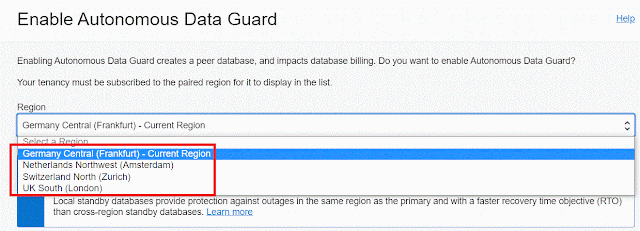Two very different in nature but equality useful features are now available in the Oracle Autonomous Database:
1. SQL Tracing in Autonomous Database
2. Cross-Region Autonomous Data Guard in ADB-S
Here is how to enable and use them:
SQL Trace in ADB:
You need first a standard bucket as SQL tracing files are only supported with buckets created in the standard storage tier. Also, create a token (you can have at most 2 tokens) and do not use your OCI password when creating the credentials.
Next, you have to create a credential for your Cloud Object Storage account. Note the full username below – do not simply use the one with what you login to the console.
BEGIN
DBMS_CLOUD.CREATE_CREDENTIAL(
credential_name => 'JULIANDON_CREDENTIAL',
username => 'oracleidentitycloudservice/juliandon@yahoo.com',
password => 'generated_token'
);
END;
/
PL/SQL procedure successfully completed.
Afterwards, set the init.ora parameters DEFAULT_LOGGING_BUCKET to specify the Cloud Object Storage URL for a bucket for SQL trace files:
SET DEFINE OFF;
ALTER DATABASE PROPERTY SET
DEFAULT_LOGGING_BUCKET = 'https://objectstorage.eu-frankfurt-1.oraclecloud.com/n/juliandon/b/adbkofa/o/';
Database altered.
Next, specify the credentials to access the Cloud Object Storage. Note that although I am doing this as the ADMIN user, I still have to prefix the credential with ADMIN. Otherwise, you get an error message.
ALTER DATABASE PROPERTY SET DEFAULT_CREDENTIAL = 'ADMIN.JULIANDON_CREDENTIAL';
Database altered.
Before we can enable SQL trace, we configure the database to save SQL Trace files:
exec DBMS_SESSION.SET_IDENTIFIER('sqltrace_jd');
PL/SQL procedure successfully completed.
exec DBMS_APPLICATION_INFO.SET_MODULE('module_jmd', null);
PL/SQL procedure successfully completed.
ALTER SESSION SET SQL_TRACE = TRUE;
After running the SQLs, disable SQL tracing so that the collected data for the session is written to a table in your session and to a trace file in the bucket you configured when you set up SQL trace.
ALTER SESSION SET SQL_TRACE = FALSE;
ALTER DATABASE PROPERTY SET DEFAULT_LOGGING_BUCKET = '';
The SQL Trace facility writes the trace data collected in the session to Cloud Object Store in the following format:
default_logging_bucket/sqltrace/clientID/moduleName/sqltrace_numID1_numID2.trc
When you enable SQL Tracing, the same trace information that is saved to the trace file on Cloud Object Store is available in the SESSION_CLOUD_TRACE view in the session where the tracing was enabled.
SELECT trace FROM SESSION_CLOUD_TRACE ORDER BY row_number;
After you close the session, the data is no longer available in SESSION_CLOUD_TRACE.
DESC SESSION_CLOUD_TRACE
Name Null? Type
---------- ----- ------------------------------
ROW_NUMBER NUMBER
TRACE VARCHAR2(32767)
Cross-Region Autonomous Data Guard in ADB-S
Autonomous Data Guard provides a standby database instance in a different availability domain in the same region or in a standby database instance in different region.
If you create the standby database in the current/local region and if the primary instance becomes unavailable – the Autonomous Database automatically switches the role of the standby database to primary and begins recreating a new standby database.
ADB currently supports up to 2 standby databases – a local one in the same-region and an additional one which is remote – called cross-region.
So, with the new cross-region standby database, you can perform a manual failover to the standby database if the current region goes down.
Note that each region has one or a few nearby paired regions in which a remote standby may be created. As you can see from the screenshot above my tenancy in Frankfurt is subscribed to 3 remote regions in which I can create a remote standby.
It is important to know that ADB-S does not allow us access to the standby databases but after a switchover or failover, the database wallet downloaded in the primary database region can be used in the remote region.
It is extremely simple to manually switchover to the other region – in my case from Frankfurt to Zurich, just with a click of a button:
Source: juliandontcheff.wordpress.com








0 comments:
Post a Comment